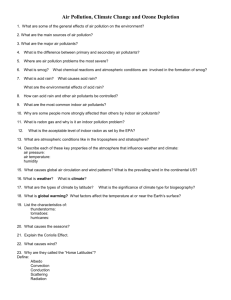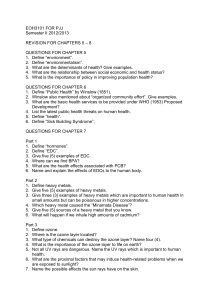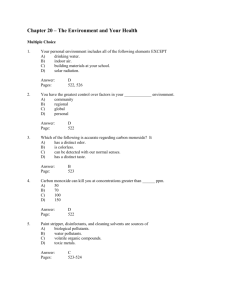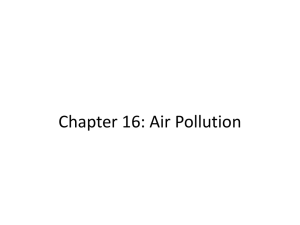HAZE - CGSS
advertisement
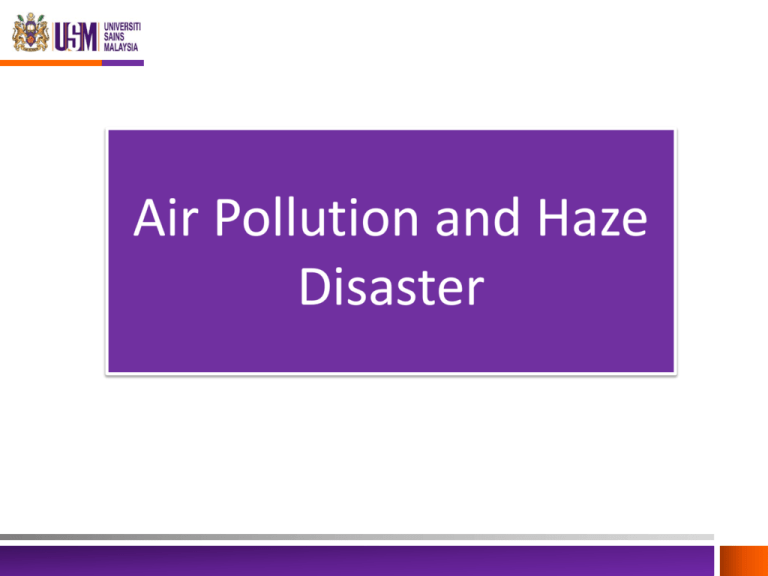
Air Pollution and Haze Disaster Air Pollution We l e a d Definition: • Air pollution is the introduction of particulates, biological molecules, or other harmful gases into the atmosphere, causing diseases, death to humans, damage to other living organisms such as animals and food crops, or the natural or built environment Outdoor Air Pollution Sources We l e a d Indoor Air Pollution Sources We l e a d Major Pollutants We l e a d Category Agriculture or Haze Mining and quarrying Industries Source Open burning Coal mining Food, beverages and tobacco Emitted pollutants SPM, CO, VOC SPM, SO2, NOx, VOC SPM, CO, VOC, H2S Textiles and leather industries SPM, VOC Wood products Paper products, printing SPM, VOC SPM, SO2, CO, VOC, H2S, R-SH Petroleum refineries Chemicals Miscellaneous products of petroleum and coal SPM, SO2, CO, VOC SPM, SO2, NOx, CO, VOC Transport Automobile vehicle exhaust NOx, CO, CO2 , PM, Hydrocarbons Power generation Electricity, gas and steam SPM, SO2, NOx, CO, VOC, SO3, Pb Indoor Printing machines, Building Materials VOC, HCHO, O3, biological contaminants, CO, CO2 Deaths due to Pollution We l e a d What is HAZE ? We l e a d • HAZE : HAZE is caused by particulate matter from many sources including smoke, road dust, and other particles emitted directly into the atmosphere, as well as particulate matter formed when gaseous pollutants react in the atmosphere. These particles often grow in size as humidity increases, further impairing VISIBILITY. • HAZE pollution can be “transboundary” if its density and extent is so great at source that it remains at measurable levels after crossing into another country’s air space. Causes- 1. Forest Fire We l e a d Causes- 2. Agricultural Waste Burning We l e a d Causes- 3. Land-clearing fires We l e a d Causes- 4. Disposal of wood waste We l e a d • Palm oil company builds windrows but continues to use or allow fire to burn slash before planting palm oil. Causes- 5. Solid Waste Burning We l e a d Why Does Haze Happen in Indonesia? We l e a d • • • • • • Cannot afford mechanical land-clearing-Fire is traditional tool No other means to dispose of wood No fear of prosecution Ineffective Fire Detection Systems Ineffective Response Systems Normal Dry Season (1 – 2 times a year) and/or Severe Extended Dry Season Increased – Prone for Forest and Land Fires Three Types of Haze We l e a d Under stagnant air mass conditions, aerosols can be "trapped" Visibility Impairment: generally associated with discoloration, haziness, and loss of color and detail. Plume: Pollutants are constrained in a tight elevated layer that can often be traced to a nearby source. Uniform Haze: Pollutants are uniformly distributed Layered Haze: Pollutants are often trapped near from the ground to a height well above the highest terrain feature. the ground beneath a temperature inversion. The top edge of the pollutant layer is visible. Haze & Visibility We l e a d Particles and gases in the atmosphere can scatter or redirect imageforming light as it travels to the eye. Through scattering, some image-forming light is removed from the view path. In addition, extra light, sunlight, and light reflected from the clouds and ground are added to the sight path, which interferes with the ability to view the scene. Scattering Another cause of visibility impairment is absorption. Particles and gases in the atmosphere absorb or remove image-forming light before it ever reaches the viewer’s eye. Although significant, absorption usually is less important than scattering processes when we talk about visibility impairment. Absorption How Pollutants Cause Haze We l e a d Extinction is a visibility metric used to describe the combined effect of scattering and absorption. It is proportional to the total amount of light removed as light passes through the atmosphere and is related to the concentration of pollutants. Parameters Describing Visual Air Quality We l e a d . It is directly related to perceived changes in visibility. As haziness increases, so does the deciview value. A one deciview change represents a 10 percent change in extinction. Most people can perceive a one deciview change. Deciview is an index of haziness that expresses changes in scene quality 1. Visual Range 2. Extinction 3. Deciview Five Types of particles that Reduce Visibility We l e a d Although particulate matter is made up of many chemical species, there are five key contributors to visibility impairment. Primary Pollutants are emitted directly into the atmosphere, and include: 1. 2. 3. 4. 5. Sulfur Dioxide Nitrogen Oxides Elemental Carbon Organic Compounds Soil or Dust Secondary Pollutants form chemical reactions involving primary gas emissions (precursors), and include: 1. Ammonium Sulfate 2. Ammonium Nitrate 3. Organic compounds Sources of particles that Reduce Visibility We l e a d Carbon Element Nitrates Sulfates Organics Soils Short Term Solution to address Haze at Origin We l e a d Fire Management (Origin) • • • • • • Sent emergency response team for fire management and rescue the victims Provide Utilities to Victims Use forecasting technology and advise Forest Department -to create buffer zones at affected area to reduce the spread, to alert publics Voluntary services from USM -healthcare center team to treat victims Use advanced technology devices (UAV) to monitor the spread and also provide healthcare utilities at rural area Damage Assessment (Economy, Health & Ecology) Short Term Solution to address Haze at Receptor We l e a d • Activation of Communication Network- Apps Technology (Warning, Information, Instruction) for public • Voluntary services at healthcare center to get utilities and treatment • Implementing Control Strategies (No outdoor activities, Health practices Technology Adoption Indoor) • Damage Assessment (Economy &Health) Long Term Solution –(Origin/ Receptor) Engineering, Education, Enforcement • Multi-stakeholder involvement - concerted, committed action Government Consistent enforcement of existing laws Develop alternative land preparation methods (no fire) Legislation & market opportunity to utilize waste wood Investment in effective fire response systems Investment in R&D for Air Pollution related technology We l e a d Long Term Solution –(Origin/ Receptor) Engineering, Education, Enforcement Businesses Sustainable management of forest resources NGOs, Media, Communities Grassroots education, training & awareness to promote environmental awareness among all sections of the society Zero burning concept Promoting the use of clean alternative and renewable energy. Transportation- reduce Sulphur content to 500 to 50ppm & Traffic Planning-Promote Public transportation Reduce Emission from Industrial Sector-adoption of new technology We l e a d We l e a d Create economically viable options for the use of wood from legal land-clearing Develop new market opportunities for use of wood that is otherwise burned Collaborators & Policy Makers We l e a d National: • NIOSH • Malaysian Department of Environment (DOE) • Other Institute in Malaysia-UKM Institute of Climate Change • Weather Department • Majlis Keselamatan Negara Regional: • ASEAN co-operation on environment International: • World Health Organization • International Union of Air Pollution Prevention and Environmental Protection Associations Air Pollution Group Research Proposal We l e a d Forecasting Technology & Assessment Health Assessment Integrated Technology to implement indoor control strategy Forecasting Technology & Assessment We l e a d Early warning system • Collecting API data (5 -10 years) from the nearest Asian countries from the meteorology station and DOE to simulate the impact level (Aerospace EngDr Parvathy Rajendran & Assoc. Prof. Dr. Mohd Zulkifli Bin Abdullah) . • Increase the Regional data collection, do trend analysis and air quality modeling (Prof Noor Azam & Prof Rahmat Awang) • advanced technologies in remote sensing, digital mapping, and instantaneous communications to predict, detect, and respond to potential crises-enforcement of Law Integrated Technology for Indoor We l e a d Implement of Indoor Control Strategy (5 teams are identified-Materials, Chemical and Electrical Eng) • Electrostatic Technology- Prof Zainal • Photocatalyst- Prof Srimala & Dr Vignesh • Super hydrophobic Filter- Dr Leo • Adsorption using activated Carbon- Prof Rahman • Green Plant –Dr. Irvan Health Assessment We l e a d Monitoring and Health Assessment (School of Medical Sciences-Dr. Ahmad Filza & Team) • Hazard identification • Exposure assessment • Dose response assessment • Risk characterization Gaps in Analysis We l e a d Strength: • Proven technologies at chemical and materials engineering that could be integrated to address indoor air pollution • Apps technology from computer science for reporting and sharing information • Have a team from the school of medical sciences to do health assessment • Have a team from civil and aerospace engineering for environmental data monitoring and imaging Weakness: • No early warning system • No comprehensive data sharing from the monitoring station closest to disaster location • No team members from economics for cost benefit analysis • No sustainable outdoor technology • Don’t have collaboration with policy makers Acknowledgement We l e a d All the team members Prof. Dr. Rahman Prof. Dr. Zainal Arifin Ahamad Prof. Dr. Nor Azam Prof. Dr. Rahmat Awang Prof. Dr. Mohd Zulkifli Dr. Parvathy Rajendran Dr. Noor Faizah Dr. Ahmad Filza Dr. Leo Choe Peng Dr. Irvan Dahlan Dr. Vignesh Ms. Norhusia Mohamed Ms. Sahareen Binti We l e a d THANK YOU
